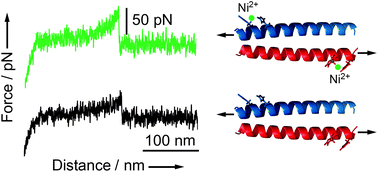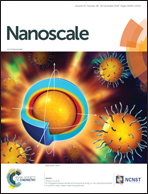Tuning coiled coil stability with histidine-metal coordination†
Abstract
Coiled coils (CCs) have emerged as versatile building blocks for the synthesis of nanostructures, drug delivery systems and biomimetic hydrogels. Bioengineering metal coordination sites into the terminal ends of a synthetic coiled coil (CC), we generate a nanoscale biological building block with tunable stability. The reversible coordination of Ni2+ thermodynamically stabilizes the CC, as shown with circular dichroism spectroscopy. Using atomic force microscopy-based single-molecule force spectroscopy, it is further shown that Ni2+-binding reinforces the CC mechanically, increasing the barrier height for dissociation. When used as a dynamic crosslink in polyethyleneglycol-based hydrogels, the single-molecule stability of the CC is directly transferred to the bulk material and determines its viscoelastic properties. This reversibly tunable CC, thus, highlights an effective strategy for rationally engineering the single-molecule properties of biomolecular building blocks, which can be translated to the emergent properties of biomimetic materials, as well as other CC containing molecular assemblies.



 Please wait while we load your content...
Please wait while we load your content...